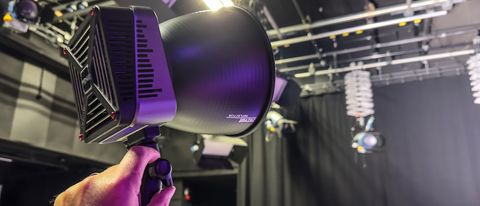Zhiyun’s first LED in the Molus series was the pocket sized Molus X100, a lightweight portable key light with a 100W of power that could emit an eye-blinding 3381 Lux. The newly released Molus G200 blows the X100 out of the water when it comes to output, with a default 200W output that can be boosted to 300W when you need that extra power. The compact Molus X100 is a useful light to illuminate subjects while out and about, making it perfect for social media content creators. The more powerful and larger Molus G200 will be of more interest to studio-based film makers than YouTube vloggers.
Zhiyun Molus G200: Video guide
Watch our video guide (above) to the Zhiyun Molus G200
Zhiyun Molus G200: Specifications

Output power (max) 320W
Input power (max) 350W
Cooling method Active Cooling
Power adapter operation voltage 100~240V AC 50~60Hz 5~2A
Color Temperature range 2700-6500K
Dimming range 0~100%
CRI (RA) ≥95
TLCI ≥97
Brightness at a distance of 1 meter on 200W power 9460 Lux
Control method via device/via Bluetooth app
Operation temperature -10℃~40℃
Extension Bowens mount
Size (header) 127x67.5x225mm
Size (adapter) 164.5x58.9x125mm
Net Weight (without standard reflector) 2.209kg
Key features

Because it is a chip-on-board (COB) light rather than an RGB LED the Molus G200 can’t emit a full-color spectrum of light – so there are no dramatic red, green, or blue gel-like effects. However, as a bi-color LED you can dial in a wide range of color temperatures in Kelvin to mimic warm tungsten light at one end of the Kelvin scale (2700K) to cooler daylight temperatures of 6500K at the other end. This enables you to match other light sources in your location or add warm or cool mood lighting to your subject.
With a default output of 200W the Molus G200 can kick out a powerful 9460 Lux key light. This output can be turbocharged to 300W if you need a stronger key light, but in our test shoot 200W was more than enough and we still had to dial down the brightness to avoid blown-out highlights on our subject. Another key feature is Music mode, which is something I haven’t encountered before on an LED. This causes the Molus G200 to flash to an audio input such as clapping hands or the beat of a tune. That could be of interest to filmmakers who need to complement a performance with creative lighting that matches the music’s tempo.
Build and handling

The Molus G200 consists of two main components. A black and grey box houses the LED. At 67.5mm thick this powerful light source is very compact. A second similarly sized box doubles up as the power pack for the G200 as well as performing control duties. The controller/power supply also has a handy strap so that you can hang it on your light stand and operate it close to hand.
There are two dials on the controller. The left dial (labelled Dim) adjusts the light intensity output for the Molus G200 between a scale of 0 and 100%. The right dial (labelled CCT) adjusts the color temperature. You can also use the right dial as a button to jump more quickly to color temperature presets (instead of having to dial them in manually). If you press both dials simultaneously then you trigger Max mode which boosts the output from 200W to 300W. The controller also has a little monochrome display screen so you can see properties such as brightness levels and color temperature.
Performance

On Max mode the output of the Molus G200 was far too bright for my studio set-up and my subject’s highlights were completely blown out. With traditional lights you need to wait for quite a while to let them cool down before you can de-rig your kit. LED lights tend to run much cooler than traditional glass lamps and thanks to the Molus G200’s DynaVort cooling system the light didn’t get too hot to handle, even when I pushed it to the max 300W output. I didn’t hear the fan operating either so it didn’t interfere with my audio recording (check out our supporting video to see the Molus G200 in action). The Molus G200 is mounted on a tilting head that enables you to rotate it through 180º, so it should be able to illuminate the subject from any angle that you require.

One nice touch is that the Molus G200 can be controlled via the ZY Vega app. It’s actually faster and more convenient to dial in a brightness value or color temperature setting by swiping the app’s sliders than it is to twiddle the physical controller’s knobs. You can also tap on preset buttons in the app to jump to specific color temperatures rather than toggle through the same presets by pressing the controller’s CCT button.
Zhiyun Molus G200: Verdict

The Molus G200 LED light is far too bright for my specific needs as a video maker but if you need to light a subject from a distance then it is well worth considering (especially thanks to its ability to boost the default 200W output to the max 300W). It will suit professional corporate and studio-based filmmakers more than social media content creators, who might be better off with the cheaper and smaller Molus X100. Music mode could be useful to certain connect creators but I imagine that it’s not a deal breaker for most people. The lack of animated preset effects (such as Flash and Lightning) is disappointing, given that they are featured on other similar COB bi-color lights such as the SmallRig COB 350D.


